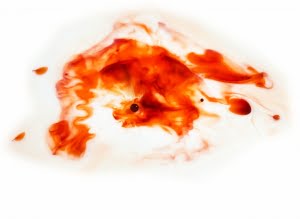Ovulation bleeding or ovulation spotting is a common monthly occurrence for many women.
There are some who have never experienced it, or only experienced it after changing birth control, but you should know that it is normal, regardless if you have the spotting or not.
Some who experience ovulation bleeding monthly use it as a reasonably reliable way to determine ovulation so they can use this sign to either avoid getting pregnant or to conceive instead.
What Causes Ovulation Bleeding

Photo: Pixabay
If the egg is fertilized, you will get pregnant, if not, then you will get your period roughly two weeks later (that’s why women talk about the “TWW” or two-week wait while trying to conceive because that’s the timeframe we have to wait before determining if implantation was successful).
During ovulatory phase of menstrual cycle, the surge in luteinizing hormone (LH) causes release of egg. The cervical mucus changes from watery to egg-white in consistency indicating the release of egg from ovary. [2].
For some, the release of the egg may cause some pain and cramps and also bleeding.
The cause of the bleeding/spotting is generally related to the sharp drop in estrogen aver ovulation before the levels of progesterone have risen [3].
But this isn’t something that has been studied regularly and researchers are still figuring out the cause of spotting.
According to one study, only 3 percent of women actually experience ovulation bleeding [4].
What Does Ovulation Bleeding Look Like
There are plenty of differences between ovulation bleeding and menstrual bleeding.
Generally, when it comes to ovulation bleeding it’s far lighter than a period and is generally light pink or brownish red [5].
For some, they also experience mild cramping as well (not unlike a period but a lot lighter and shorter in duration).
It may be mixed with cervical mucus and may be accompanied by mild pain in the stomach or some cramping that resembles menstrual cramping. Not all bleeding can be regarded as ovulation spotting.
If you notice heavy bleeding that lasts for days and looks like you are menstruating, consult a doctor immediately.
How Long Does Ovulation Bleeding Last?
Ovulation bleeding doesn’t usually last long. The average time frame is one to three days [6].
So if you have experienced spotting for a longer period of time, this is something you’ll want to be seen by a doctor because it can be a sign of something more serious or an underlying problem.
When it comes to the timeframe as to when you might see ovulation bleeding, it would happen around 14 days prior to your next period (or anywhere from 11-21 days from the first day of your last period [7]).
If it were implantation bleeding it would only happen about a day or two prior to your period [8] (which is why it’s sometimes confused for a period instead).
Ovulation Bleeding As a Birth Control Method
Those who experience ovulation bleeding in the middle of each cycle, can use this to help them either prevent or get pregnant.
Ovulation bleeding indicates that the egg has been released and is available for fertilization by sperm. So, if you are trying to get pregnant, it’s the perfect time to try.
In that same sense, if you are trying to avoid the pregnancy, you can use the same method.
But again, this is not a 100% sure way to avoid pregnancy and additional methods should be used if you are really trying to avoid starting or growing your family.
In addition to monitoring ovulation with spotting, there are a lot of people who use this in conjunction with measuring their basal body temperature in order to determine exactly when they are ovulating.
This is considered natural family planning and when done right can be extremely reliable; however, the failure rate of this method is high.
Other Signs of Ovulation
While ovulation bleeding is an amazing tool to either prevent or attempt to get pregnant there are also a few other ways to help determine that you are ovulating.
Other signs that indicate ovulation include changes in the cervical fluid, changes in the basal body temperature, increased sex drive, increased breast tenderness, and heightened senses as well [9].
Final Thoughts
Ovulation bleeding can be a way to tell when you are ovulating and when you are most fertile. If you are having regular bleeding or unusually painful cramps, that’s something that you want to discuss with your doctor to make sure there are no additional underlying conditions.
Again, it can be completely normal (I am one of the 3 percent that have ovulation bleeding) and your body’s way of telling you the perfect time to have intercourse. It also could be something you want to look into further at least once just to be sure.
References
- Clar McWeeney via Clue. Ovulation bleeding: What it is, and How to Know If You’re Experiencing It. [link]
- See above #1
- See above #1
- Menstrual Bleeding Patterns Among Regularly Menstruating Women [link]
- Anisha Nair via Parenting First Cry. Bleeding During Ovulation: Causes and Things to Know. [link]
- See above #5
- See above #4
- See above #5
- See above #4




Hi, I had my period on the 11th to the 17th of September. I started light spotting on the 7th of this month, my period due was the 9th of this month and i haven’t gotten a flow at this time, just been using panty liner. since then is this consider ovulation bleeding or implantation bleeding
Hello Neisha, if your period is regular it can be implantation bleeding. Implantation bleeding is light pink to dark brown in color. Menstruation bleeding is usually bright to dark red.
Implantation bleeding is much lighter in flow than your period.
Implantation bleeding only lasts for half a day to a couple of days. Periods typically last longer than this.
And also when you are ovulating you can see increase in cervical fluid.
I’m 7 days post af and I have wiped light pink blood while Peeing. Would this be ovulation bleeding? I haven’t been on any birth controls for almost a year and never had bleeding this soon after af
Hi Brittany, yes it’s possible that it’s ovulation spotting. Our cycles can change throughout our lives depending on our situations and just our bodies changing. Completely normal.
Hi. I had my period on June 21st-25th then had unprotected sex on June 29th. I started cramping today and started bleeding. Is this normal?
Hi Susan, it could be ovulation bleeding a bit early (or if you have a cycle shorter than 28 days). Ovulation bleeding though should not be as significant as a regular period though. If it continues I would try to make an appointment with your doctor.
I’ve only in the past few months started to experience ovulation bleeding. About 1 week ago i had some cramping and a little blood in the egg white cervical mucus, and that light spotting in the mucus has continued over the past 6 days. Is this ovulation bleeding or does this extended light spotting call for a doctor visit?
Hi there Sonji, if this is unusual to you then see your doctor.
On day 7 of my ovulation, when I wipe theres a little light pink blood. And now its day 11 and still having the same problem, should it be something to worry about?
Hi Lala, not something to worry about at all unless you are experiencing a lot of blood that is soaking through either a tampon or a pad, at irregular intervals. However light pink spotting could be ovulation bleeding, implantation bleeding, or if you are about to have your period it could be the start of that.
I last had my period on the 11th September and had unprotected sex with my partner on the 17 and 18 September and took an emergency pill on the 19th of September. Now its the 25th September and I am expecting to ovulate but I woke up with light spotting which was pink in color and had turned brown accompanied by light cramping. Could this be implantation bleeding or ovulation bleeding?
Hi Vinolia, taking plan B can most certainly affect your period, spotting, everything in between. Its a hormone. As long as you took the pill within 72 hours of unprotected sex you should be safe. Most likely you are experience either breakthrough bleeding, however know that your cycle this month could be a bit altered from what you normally are used to.
In such a case when should one test for pregnancy? Can one have implantation bleeding 2 weeks before their next due period?
Hello Alicia, the best time to test for pregnancy is the first day of your missed period. It could be implantation bleeding, but if it is a really small it could be ovulation as well.